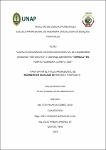Caracterización del sistema agroforestal de Caryodendron orinocense "metohuayo” y Cedrelinga cateniformis “tornillo" en Puerto Almendra, Loreto. 2022
Abstract
The purpose of this research was to characterize the agroforestry system of Caryodendron orinocense "metohuayo" and Cedrelinga cateniformis "tornillo" in Puerto Almendra. The study was a quantitative, cross-sectional, descriptive, non-experimental research design. The population corresponded to all the plants located in the Center of Proceedings of Forest and Agricultural Species of the Faculty of Forestry Sciences of the National University of the Peruvian Amazon and the sample included all the plants of the metohuayo and tornillo agroforestry system. The results indicate that the natural fertility of the soils where the agroforestry system was established is low. However, the proposed system is applicable, taking with caution the results of the forestry component, which did not show a good reaction to external factors, leading to high mortality, so that the metohuayo has a survival rate of 68.50% and the tornillo 35.00% survival rate. For its part, the agricultural component shows that the banana exceeds 75.89% survival, cassava with a survival of 96.09%, pineapple with a survival of 64.58%, copoazú with a survival of 81.25% and, finally, the mandarin with a survival of 62.50%. In addition, yucca of two varieties included in the study were harvested. La presente investigación tuvo como propósito caracterizar el sistema agroforestal de Caryodendron orinocense "metohuayo" y Cedrelinga cateniformis “tornillo" en Puerto Almendra. El estudio fue cuantitativo, del tipo de investigación transversal, con diseño de investigación no experimental, de nivel descriptivo. La población correspondió a todas las plantas ubicadas en el Centro de Procedencias de Especies Forestales y Agrícolas de la Facultad de Ciencias Forestales de la Universidad Nacional de la Amazonía Peruana y la muestra incluyó a todas las plantas del sistema agroforestal de metohuayo y tornillo. Los resultados indican que la fertilidad natural de los suelos donde se estableció el sistema agroforestal es baja. Sin embargo, el sistema propuesto es aplicable, tomando con precaución los resultados del componente forestal, que no evidenció una buena reacción por factores externos, propiciando una elevada mortalidad, de esa manera, se ha logrado que el metohuayo tenga una sobrevivencia de 68,50% y el tornillo 35,00% de sobrevivencia. Por su parte, el componente agrícola muestra que el plátano supera el 75,89% de sobrevivencia, la yuca con una sobrevivencia de 96,09%, la piña una sobrevivencia de 64,58%, copoazú una sobrevivencia de 81,25% y, por último, la mandarina con una sobrevivencia de 62,50%. Adicionalmente, se logró cosechar yucas de dos variedades incluidas en el estudio.
Collections
- Tesis [402]


